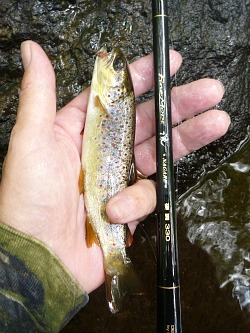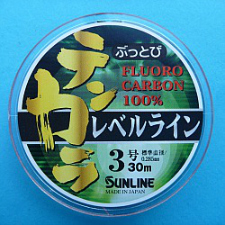Trip Report 4-14-13
I need to preface this report with a brief explanation for the blue flies. Some time previously, I had become interested pesca a mosca Valsesiana, which is the traditional Italian fixed line fly fishing method. It is pretty similar to tenkara, but uses three or four flies at a time rather than just one. Andrea Scalvini, who has a website and rod company promoting the traditional style, and who I had peppered with questions about the technique and gear, had sent me a cast of four flies. One of them had a blue silk body. That got me wondering why there were no blue flies (or at least, none that I'd ever heard of). I launched a Blue Fly Challenge to catch the first, most, largest and smallest fish with a fly that incorporated a particular blue yarn.
This trip report will cover two themes: putting more blue flies to the test and also experimenting with some extremely light tenkara lines. The stream was a small wild trout stream in New Jersey.
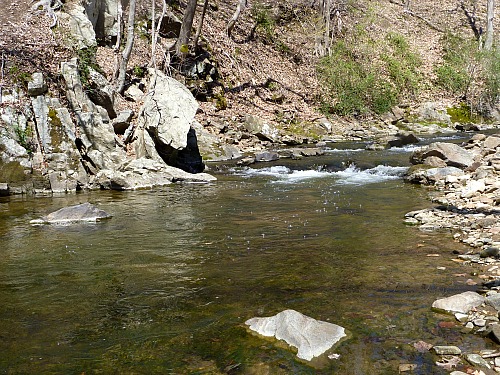 The stealth pool - if you are close enough to use the plunge to sink your fly you have already spooked all the fish in the pool.
The stealth pool - if you are close enough to use the plunge to sink your fly you have already spooked all the fish in the pool.Blue Flies
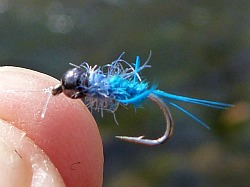
I should have taken a picture before catching a fish because the first fish's teeth have already damaged the fly. I wanted to find a blue equivalent to a pheasant tail nymph - a "go to" fly for many fly fishermen. I couldn't find blue pheasant tail, but I did find some blue goose shoulder. I suspect it is used for wing material in full dress salmon flies, but it wraps and looks a lot like pheasant tail (other than being bright blue, of course).
The fish seemed to approve.

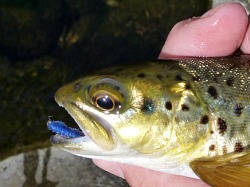
I then switched to a blue Killer Bug, which had not worked for me the first time I tried it. Today it did. Nothing subtle about the fly and nothing subtle about the take, either. The line shot forward about 6 inches.
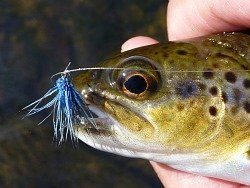
Next up was blue deer hair and wool. As mentioned in last week's tenkara trip report, when wool yarn is treated with Water Shed, it floats quite nicely. This one floated for all of about 15" before this little brownie nailed it. I still don't know how well it floats after being slimed, though, because with this fish it was then on the next fly.
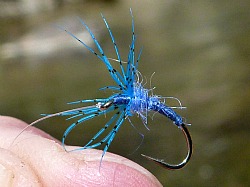
This one gave me fits. I was at a nice pool, just above where I had caught the previous fish. There were a few fish rising in the pool and I had several takes. For some reason I missed them all. With each missed fish I caught a tree, though, and each tree claimed a fly. It wasn't long before I had no more of the blue sakasa kebari. I do kind of like the blue-dyed silver pheasant feathers for hackle, though.
I then proceeded to miss a few fish on a blue killer bugger, too. Even though I didn't catch any fish on the sakasa kebari or the killer bugger, they both fooled fish.
Light Lines
Now that a few "Oni rods" (produced by Masami Sakakibara, "Tenkara no Oni") have appeared on these shores, a lot has been made about their ability to cast a very light line. I was lucky enough to cast an earlier version of the Oni rod a couple years ago in Japan and was awestruck by its light weight and responsiveness. (Of course, up until that point I had not fished with any Japanese rods.) I have no doubt that the current Oni rod is an amazing rod.
With the recent commentary about a rod that was designed to cast lines smaller than a size 3, I decided to see what a few more readily accessible rods could do.
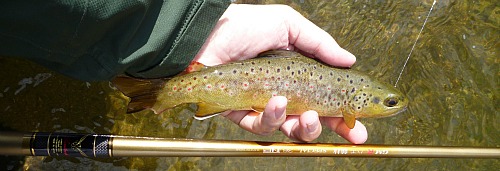
The first rod I tried is one you'll be hearing more about here once I get time to write a page for it. It is the Suntech GMR Special 36NP. What I find most surprising about the rod is that it is a seiryu rod with backbone. Seiryu rods tend to be quite soft, as they are designed for catching smaller fish. This one reminds me a bit of the Soyokaze in that it has a soft tip, which allows it to cast a light line, but then it stiffens up and can handle surprisingly large fish for a seiryu rod. It is the rod with which I caught the 18" fish shown on my Killer Bugger page. It had no problem at all controlling that fish, which is just amazing for a 1.6 ounce rod!
The fish were a lot smaller today, but so was the line. The fish above was caught while casting a size 1.5 line.
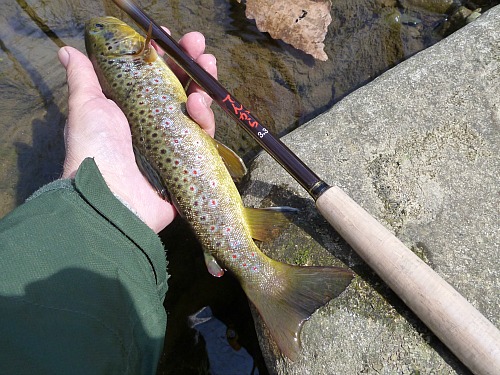
After that I decided to take a bold move. If a top quality rod, designed for delicate fishing, could cast a size 1.5 line, how about an entry level rod? Well, it turns out that the Shimotsuke Tenkara 3.3, which sold for all of $99 could do it, too. The fish shown above, at just under 12", was my best fish of the day. It took a yarn bodied soft hackle, cast with a size 1.5 line.
I find that the yarn bodied flies are a good match for light lines. The yarn, as long as it is not treated with floatant, will absorb water and the extra weight definitely does help in turning over the tippet. Ultra light lines do not have a lot of mass and therefore do not have a lot of energy to transmit to the tippet. Having a wet fly that carries a little water weight certainly helps. The water weight of the wet yarn helps with the cast, but it doesn't sink the fly. After all, the water that wets the yarn is no heavier than the water in the stream.
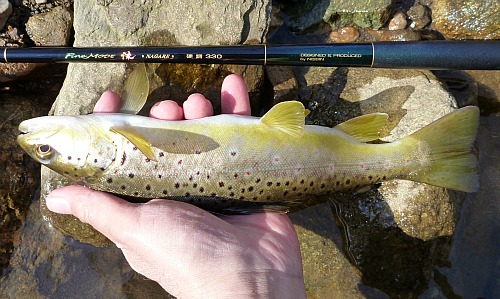
I then switched to one of my absolute favorite rods for light line fishing. The Nissin Fine Mode Nagare is a very soft rod, and very soft rods cast light lines much better than stiffer rods. If you like soft rods, it is just a wonderful little rod for little wild fish. The fish above, which was about 11", stayed in the pool where it was hooked. It was no problem to land but a 12-14" fish in current would be. The rod is just over 11 feet long yet weighs just 1.1 ounce.
The line that Charles Cotton described in The Compleat Angler, which was so light that generations of fly fishermen thought he must have been dapping (sound familiar?), was constructed of two hairs "nearest to the hook" but then tapered up to as many as 7 hairs. The line I used today with this rod was a level two hair line - with a one hair tippet. It accounted for several fish, but I did discover that even modest fish hit a killer bugger (even a blue one) hard enough that a single horsehair will not hold them.
I then tried a line made in the same fashion as the lines that Eiji Yamakawa demonstrated at the 2012 Tenkara USA summit. Instead of the three twisted strands of 1X, 2X and 3X tippet that Eiji used, I made this line of three strands of 4X, 5X and 6X. It is a very light line! With a little practice it was not a problem to cast, though. The problem was that it was almost impossible to see. It was so thin, and the Varivas tippet material I used to make it is clear, so it was almost like casting clear fluorocarbon line. I don't know if the fish couldn't see it, but I sure couldn't. I missed several strikes. I didn't see them and by the time I felt them it was too late.
The upshot
I do not want anyone to misconstrue this essay and think I am comparing myself to Tenkara no Oni. I'm not. He is an amazing caster. I get by. Also, I was not making 30' casts. Similarly, I am not comparing the Shimotsuke Tenkara 3.3 to the Oni Rod - it is in a different league. My point is that with practice you can cast a lighter line than you think with more rods than you think. One thing is sure, though, you'll never learn to cast a light line if you start with and stay with a 4.5 line or furled lines that absorb water.
To me, the very essence of tenkara is the light line, and I would urge you to fish with the lightest line you can get away with. If you fish on a windy day, you'll have problems. You cannot cast a size 1.5 line into a breeze. On a still day, though, with a fly that is not wind resistant, you'll be able to hold your line off the water much better with a lighter line than with a heavier line. I would not start out trying to cast a size 1.5 line. Heck, it is hard to even find a size 1.5 line or even a 2. I would suggest getting a size 2.5 or 3 if you don't have one, and if you don't have one of the stiffer rods like a Kiyose SF that just doesn't cast a light line well. (That rod does other things so well that it might be worth having even if you can't cast light lines with it.)
Most of the rods out there will cast a size 3 line. Try it. I think it will help your fishing.
TenkaraBum Home > Tenkara Trip Reports > Trip Report 4-14-13
“The bitterness of poor quality remains long after the sweetness of low price is forgotten” - Benjamin Franklin
"Be sure in casting, that your fly fall first into the water, for if the line fall first, it scares or frightens the fish..." -
Col. Robert Venables 1662
As age slows my pace, I will become more like the heron.
We've all had situations where seriously chewed up flies kept catching fish after fish after fish. It is no sin to tie flies that come off the vise looking seriously chewed up.
Warning:
The hooks are sharp.
The coffee's hot.
The fish are slippery when wet.
Beware of the Dogma
Seriously, all the hooks sold on TenkaraBum.com, whether packaged as loose hooks or incorporated into flies, are sharp - or as Daiichi says on their hook packages, Dangerously Sharp. Some have barbs, which make removal from skin, eyes or clothing difficult. Wear eye protection. Wear a broad-brimmed hat. If you fish with or around children, bend down all hook barbs and make sure the children wear eye protection and broad-brimmed hats. Be aware of your back cast so no one gets hooked.
Also, all the rods sold on TenkaraBum.com will conduct electricity. Do not, under any circumstances, fish during a thunder storm. Consider any fishing rod to be a lightning rod! Fishing rods can and do get hit by lightning!
What's in stock?
Kurenai II AR 30F
Kurenai II AR 33F
Kurenai II AR 39F
TenkaraBum 33
TenkaraBum 36
Furaibo TF39
Furaibo TF39TA
Nissin Oni Tenkara Line
If you enjoy spin fishing or baitcasting please visit my sister site Finesse-Fishing.com.



